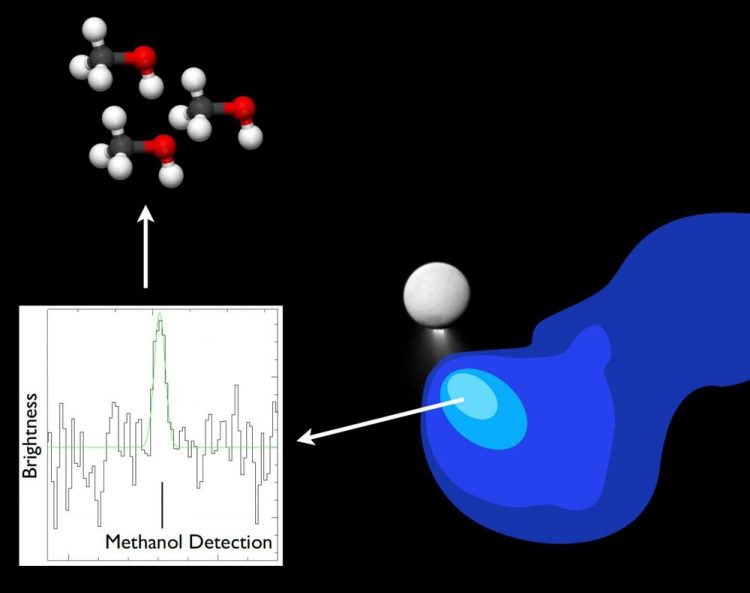Surprise methanol detection points to an evolving story of Enceladus's plumes

Image of Enceladus with the location of a possible confined methanol cloud, the methanol spectrum from the study and images of the methanol molecule. Credit: E. Drabek-Maunder, background image NASA/JPL-Caltech/Space Science Institute
Enceladus's plumes are thought to originate in water escaping from a subsurface ocean through cracks in the moon's icy surface. Eventually these plumes feed into Saturn's second-outermost ring, the E-ring.
Drabek-Maunder says: “Recent discoveries that icy moons in our outer Solar System could host oceans of liquid water and ingredients for life have sparked exciting possibilities for their habitability. But in this case, our findings suggest that that methanol is being created by further chemical reactions once the plume is ejected into space, making it unlikely it is an indication for life on Enceladus.”
Past studies of Enceladus have involved the NASA/ESA Cassini spacecraft, which has detected molecules like methanol by directly flying into the plumes. Recent work has found similar amounts of methanol in Earth's oceans and Enceladus's plumes.
In this study, Dr Jane Greaves of Cardiff University and Dr Helen Fraser of the Open University detected the bright methanol signature using the IRAM 30-metre radio telescope in the Spanish Sierra Nevada.
“This observation was very surprising since it was not the main molecule we were originally looking for in Enceladus's plumes,” says Greaves.
The team suggests the unexpectedly large quantity of methanol may have two possible origins: either a cloud of gas expelled from Enceladus has been trapped by Saturn's magnetic field, or gas has spread further out into Saturn's E-ring. In either case, the methanol has been greatly enhanced compared to detections in the plumes.
Team member Dr Dave Clements of Imperial College, points out: “Observations aren't always straightforward. To interpret our results, we needed the wealth of information Cassini gave us about Enceladus's environment. This study suggests a degree of caution needs to be taken when reporting on the presence of molecules that could be interpreted as evidence for life.”
Cassini will end its journey later this year, leaving remote observations through ground- and space-based telescopes as the only possibility for exploring Saturn and its moons – at least for now.
Drabek-Maunder adds: “This finding shows that detections of molecules at Enceladus are possible using ground-based facilities. However, to understand the complex chemistry in these subsurface oceans, we will need further direct observations by future spacecraft flying through Enceladus's plumes.”
Media Contact
All latest news from the category: Physics and Astronomy
This area deals with the fundamental laws and building blocks of nature and how they interact, the properties and the behavior of matter, and research into space and time and their structures.
innovations-report provides in-depth reports and articles on subjects such as astrophysics, laser technologies, nuclear, quantum, particle and solid-state physics, nanotechnologies, planetary research and findings (Mars, Venus) and developments related to the Hubble Telescope.
Newest articles

Recovering phosphorus from sewage sludge ash
Chemical and heat treatment of sewage sludge can recover phosphorus in a process that could help address the problem of diminishing supplies of phosphorus ores. Valuable supplies of phosphorus could…

Efficient, sustainable and cost-effective hybrid energy storage system for modern power grids
EU project HyFlow: Over three years of research, the consortium of the EU project HyFlow has successfully developed a highly efficient, sustainable, and cost-effective hybrid energy storage system (HESS) that…

After 25 years, researchers uncover genetic cause of rare neurological disease
Some families call it a trial of faith. Others just call it a curse. The progressive neurological disease known as spinocerebellar ataxia 4 (SCA4) is a rare condition, but its…





















